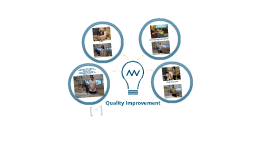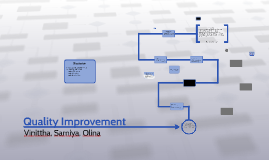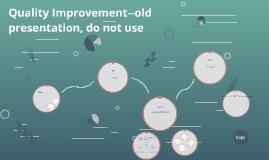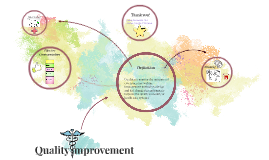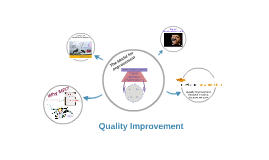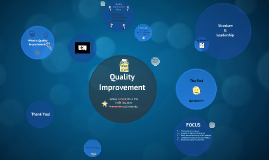Quality Improvement
Transcript: quality improvement for client care can be measured by the overall value of care Value= (Quality of outcome)/Cost (Kelly & Crawford, 2013) a. Unexpected survey b. Patient satisfactory survey c. Accrediting Health Region Focus on an improvement idea Organize a team that understands the process Clarify what is happening in the current process Understand the degree of change needed Solution. Selection a solution for improvement. (Kelly & Crawford, 2013) Vinittha, Samiya, Olina Think about the following when formulating your answer: why is it an issue? who is involved? who does it affect? (Noseworthy, 2011; Canadian Institute for Health Information, 2014) ( Accreditation Canada, 2015) -hospitals • Reducing wait times -physicians -drugs • Controlling cost Process Improvement Tools The Plan-Do-Study-Act Cycle (PDSA) goal: increase the ability to predict the effect that one or more changes would have if they were implemented (Kelly & Crawford, 2013) Quality Improvement Quality Improvement Principles History of Quality Assurance To conclude: Quality improvement ensures that it, the product, service or process, is of sufficient quality tools such as the PDSA cycle and the FOCUS methodology can be used as guidelines for change QI strategies direct allocation of resources to increase the value of care Thanks for listening! Regulatory Requirements: Accreditation Canada (AC) Quality Assurance (QA) "doing it right" Total Quality Management (TQM)-also referred to as Continuous Quality Improvement (CQI) and Performance Improvement (PI) "doing the right thing" (Kelly & Crawford, 2013) voluntary process helps health care organizations improve their performance for the benefit of clients and the health system Who gets accredited? community care hospitals and health systems specialty health services seniors' care (Accreditation Canada, 2015) Discussion Quality Improvement Equation References (Kelly & Crawford, 2013) WHO WANTS TO BE A MILLIONAIRE: NURSING EDITION Compare and contrast the two quality improvement tools: Quality Assurance Vs. Continuous Quality Improvement Today, you will learn the following: 1. Definition and history of performance improvement/quality assurance activities. 2. Some commonly used process improvement tools e.g. PDSA cycle, the FOCUS methodology. 3. The impact of performance improvement measures on client care and resource utilization. The Focus Methodology References Accreditation Canada. (2015). The value and impact of health care accreditation: A literature review. Ottawa, ON: Accreditation Canada. Available on http:// http://www.accreditation.ca/ pp. 1-6. Canadian Institute for Health Information. (2014). How much does Canada spend on health care? National health expenditure trends, 1975 to 2014. Ottawa, ON: Canadian Institute for Health Information. Available on http://www.cihi.ca/ Ettorchy-Tardy, A., Levif, M., & Michel, P. (2012). Benchmarking: A method for continuous quality improvement in health. Healthcare Policy, 7(4), pp.101-119. doi: 10.12927/hcpol.2012.22872 Kelly, P., & Crawford, H. (2013). Nursing leadership and management (2nd Canadian ed.) Toronto, ON: Nelson Education. Li, M., & Green, E. (2013). The Ontario psychosocial oncology framework: A quality improvement tool. Psycho-Oncology, 22(5), pp.1177-1179. doi: 10.1002/pon.3116 Noseworthy, T. (2011). Health Resource Allocation: A made-in-Canada description. Journal of Legal Medicine, 32(1), 11-26. doi:10.1080/01947648.2011.550823 FOCUS Methodology Focus on an improvement idea Organize a team that understands the process Clarify what's happening in the current process Understand degree of change needed Select a solution for improvement What is quality improvement? process of monitoring and assessing a product, service, or process uses data to drive decisions Purpose? to ensure that it, the product, service or process, is of sufficient quality focused on improving client care processes and outcomes (Kelly & Crawford, 2013) priority to benefit the client quality is achieved through the participation of everyone in the organization improvement opportunities are developed by focusing on the work process decisions to change or improve a system or process are made based on data committed leadership necessary education and long-term commitment are required (Kelly & Crawford, 2013) Quality Improvement Implications for Resource Allocation Imagine you are a nurse manager. Infection-control practitioners have revealed that your unit's use of Foley catheters is above average. It is your responsibility to form a solution to this issue. brainstorm reasons why the Foley catheter use is so high after you have identified the root causes for the above-average use of Foley catheters, use the PDSA Cycle to identify improvement strategies present your ideas (Ettorchi-Tardy, Levif & Michel, 2012) Focus of Continuous Quality Improvement (doing the right thing) Meeting the needs of the customer Building quality performance into work process Assessing the







